Best tips: how to properly dry onions after harvesting from the garden
Onions are a healthy vegetable that is eaten fresh, fried, pickled, stuffed or baked, added to first and second courses, and widely used in folk medicine. It is not surprising that this crop is grown in almost every garden.
However, it is not enough to grow a turnip. In order for onions to be stored for a long time and not spoil, it is important to dry them properly after harvesting. In this article we will tell you how to properly dry onions after harvesting from the garden.
Timing and technology of cleaning
Only those onions that are stored in time will be stored for a long time.. If you dig it up early, the too thick and juicy neck of the bulb will take a long time to dry, which will increase the risk of rot and fungal diseases.
If you delay harvesting, the bulbs will become overripe and the upper scales will crack.. This in turn will lead to rapid deterioration of the product during storage. Overripe onions develop a secondary root system, which worsens the taste of the turnip.
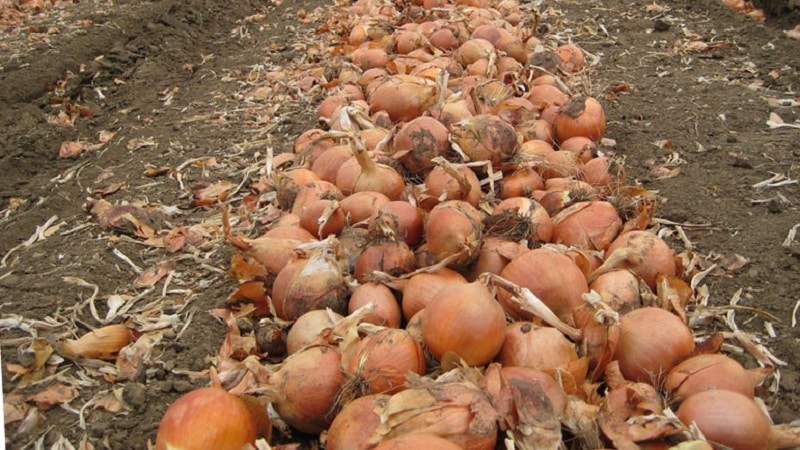
When to dig? Turnips are removed from the beds after the feathers wither. If 60-80% of the leaves have fallen, it’s time to start harvesting. On average, this time falls in the second half or end of August.
Need to know! The onion is removed after the feather has been laid down. At this time, the growth of the heads stops, and the maximum amount of nutrients accumulates in them.
Another sign of a ripe vegetable – formed cover leaves that have acquired a characteristic color for the variety.
A timely harvest is the key to successful storage.. If you start harvesting onions earlier, when the feathers have not yet died, the neck of the onion will be too thick and juicy - this increases the risk of rotting of the bulbs.
Helpful advice. If the time for harvesting has already come, and the feather has not yet died, then the ripening of the bulbs can be accelerated. To do this, it is enough to cut the roots with a sharp shovel at a depth of about 5 cm. This way you will reduce the nutrition of the plants and speed up ripening.
Harvest
Digging is carried out in dry, sunny weather.. It is advisable that there is no rain 1-2 weeks before harvesting. Then the earth will dry out and the collected heads will not have to dry for a long time.
If the soil is light and loose, the onion is simply pulled out of the ground. But if the soil is dense and heavy, the bulbs are dug up. Otherwise, most of the pulled out heads will remain without bottoms and will rot in a few weeks.
It is more convenient to dig up the crop with a small fork. They are stuck into the rows at a short distance from the bulbs and the layer of soil is slightly raised.
To onions after harvesting was stored for several months, before storing it, it is dried.
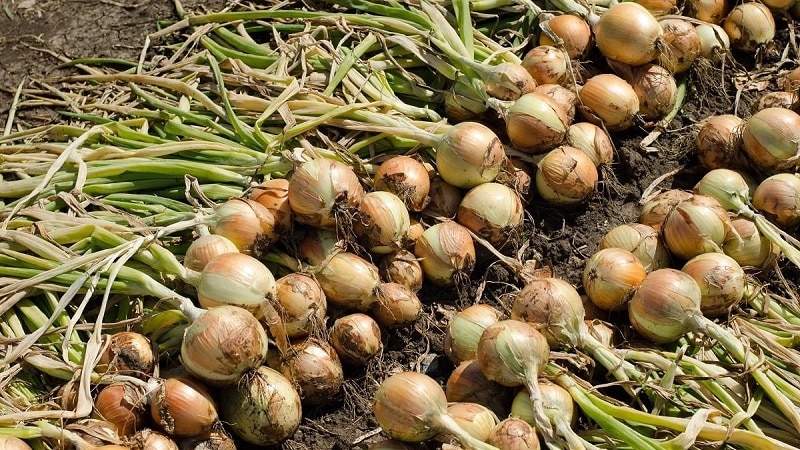
The influence of grade on harvesting time and shelf life
Depending on the variety and growing conditions, the growing season of onions lasts on average from 65 to 85 days. Early varieties ripen by the end of July, and later varieties are ready for harvesting in late August - early September.
Attention! Only late and spicy varieties are suitable for winter storage. The remaining varieties are used for preparations or eaten immediately after collection.
Leeks are dug up later than turnips.. Harvesting begins in mid-September - early October (grown leeks are not afraid of the first frosts).To make the onions whiter, 10-14 days before removal from the garden, the lower part of the plants is sprinkled with earth or covered with light-proof material. After digging, the roots and leaves are cut off.
Harvesting of shallots begins from the end of July to mid-August. As in the case of turnips, delaying harvesting leads to the germination of the bulbs and the appearance of new roots. Shallot nests are dug up, divided into bulbs and dried.
Features of drying onions
The onion is dug up, cleaned of lumps of earth, roots and feathers are trimmed. Before storing the heads for winter storage, the onions are dried.
Need to know! Drying onions after harvesting reduces the risk of developing fungal diseases and spoilage of the vegetable during storage.
How to dry onions from the garden? Let's talk about the features of drying each type.
Bulb
There are several ways to dry onions. The simplest and most accessible is drying in the sun directly in the garden. If the weather permits, the dug vegetables are laid out in one layer and dried in the sun, turning over periodically. After 3-4 days, the bulbs are ready for storage.
If the weather is rainy, then the heads are moved to a ventilated area. (under a canopy, in the attic, etc.). The onions are laid out in a single layer on the floor or poured into nets and hung vertically on a rope.
You can weave onions into buns or braids and dry them that way. Indoor drying takes one to two weeks depending on temperature and humidity.
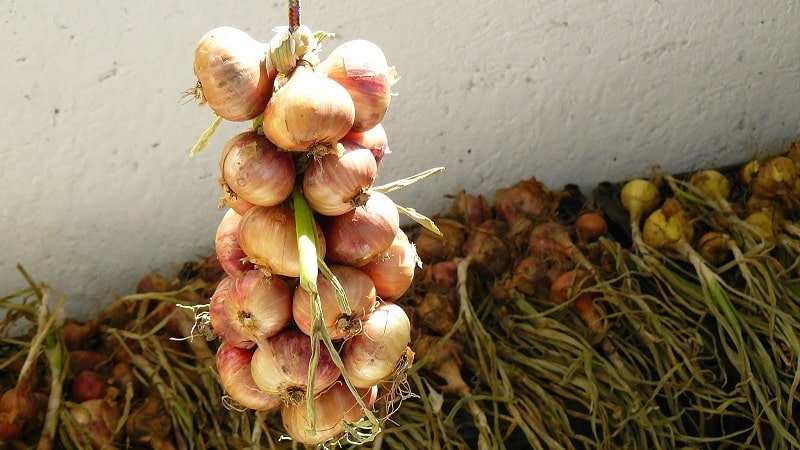
The fastest drying method is in the oven.. The bulbs are laid out on a baking sheet in one layer and placed in the oven, preheated to +30...+35°C. At the same time, the oven is periodically turned off so as not to dry out the heads. Overdried onions with cracked covering scales will not be stored for long.
Sevok
Onion sets are also dried after harvesting.. The bulbs are laid out in a thin layer on thick fabric or flooring and placed in the sun. The heads are periodically turned over. In the open air, the sets are dried for at least three days.
During the rainy season, the seedlings are dried under a canopy. or in a well-ventilated area. Drying takes 1-2 weeks.
Chernushka
Nigella are black onion seeds. They are also dried to prevent spoilage during storage. Seed drying is carried out in 3 stages:
- During the first 5-7 days, nigella is kept in a room with good ventilation at a temperature of +20°C.
- Then the room temperature is raised to +30°C and dried for another week.
- At the final stage, the air temperature is raised to +35°C and the seeds are dried for another week.
The dried nigella is poured into a linen bag or paper bag. and put away in a dry place.
Methods for drying onions for the winter
If there is no suitable room for storing fresh onions, then the vegetable can be dried. In this case, from 1 kg of fresh product you will get about 100 g of dried product. Before drying, the onions are washed, peeled from the top scales and cut into cubes or rings.
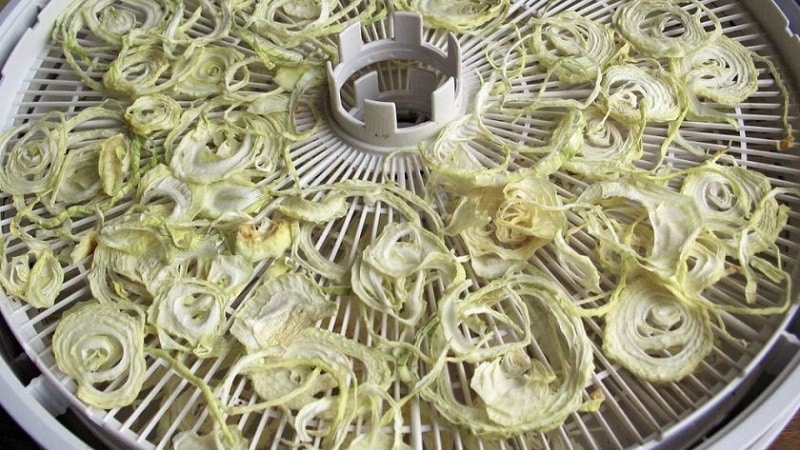
Let's consider several affordable ways to prepare healthy seasoning.
In the oven
Oven Suitable for drying onions, leeks and green onions.
Before drying, vegetables are washed, peeled and cut into cubes or rings. Then the pieces are laid out on a baking sheet and placed in the oven, preheated to +40...+50°C. Higher temperatures will dry the onions faster, but may burn.
The pieces are dried for about 2-3 hours, stirring occasionally.
In the microwave
To dry onions in the microwave: Place the chopped pieces on a paper napkin, cover with a second napkin and place in the oven for 3 minutes. If this was not enough, the time is increased.
The microwave is suitable for drying vegetables in small quantities, however, this method is not suitable for preparing large quantities of seasoning - it will take too much time, effort and electricity.
In a convection oven
In a convection oven drying occurs due to the flow of hot air. Heated air constantly circulates inside the grill and dries the onion rings evenly. Preparing dried vegetables using this modern device preserves their beautiful appearance, pleasant taste and nutrients.
Drying in the grill at a temperature of about +70°C takes about an hour. It is better to keep the lid slightly open.
In an electric dryer
Electric dryer is suitable for drying chopped green onions and pieces of onion.
Green onions are cut and placed in a tray to dry. The turnip is cut into pieces and pre-blanched in boiling water for two minutes. Before placing in the dryer, the pieces are cooled in cool water and laid out in a thin layer on trays.
Onions in the electric dryer dried at a temperature of +65…+70°С. The trays are swapped several times for uniform drying.
Outdoors
If there are no special devices, then onion rings can be dried in the open air. To do this, sliced vegetables are laid out on racks and placed in a shaded, well-ventilated place.
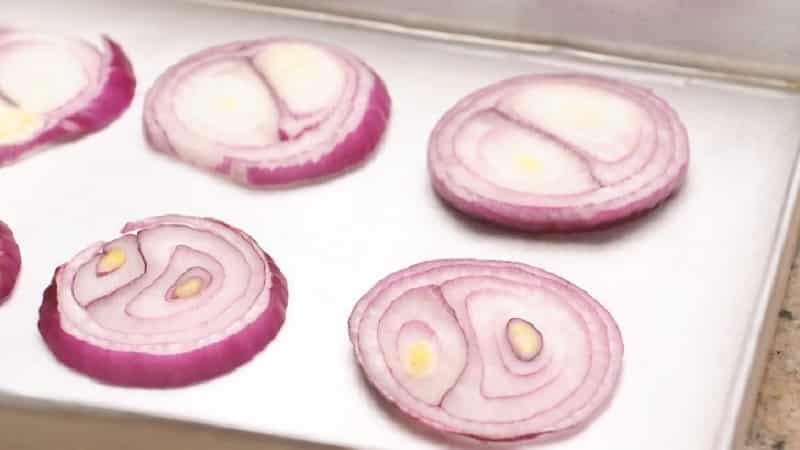
To protect against insects, the grates are covered with gauze.. So the vegetables are dried for several days, stirring daily.
How to determine readiness
Dry onions for the winter at home you can use any of the methods listed above. When dried, the vegetable retains its bactericidal effect and beneficial substances..
How do you know if the seasoning is dried correctly? Well-dried onion rings become brittle and crispy. The color of the pieces is light yellow. The taste of the seasoning is mild, with a spicy aroma.
Signs of poorly dried onions
Poorly dried seasoning will quickly spoil, therefore, when preparing dried vegetables, it is important to thoroughly dry all the slices. Insufficiently dried pieces are distinguished by their white color and retained pungent taste. Under-dried onions are moist to the touch and do not crunch when pressed.
Storage rules
It is important to know about the nuances of storing vegetables in fresh and dried form.
Storing dried onions
Dried seasoning is stored in containers with lids.. It is preferable to use lids with perforations for air access. If there is no special lid, use parchment paper or thick cloth, securing it to the neck of the glass container.
Linen bags and paper bags are also suitable for storage.. It is important that they are not exposed to moisture during storage.
Storing fresh onions
It is convenient to store dried onions from the garden in boxes or cardboard boxes. A small amount of vegetables is poured into each box, in one layer of 25-30 cm. Holes are made in the side walls of the box for air access.
Also for storing bulbs use canvas bags, place them in a dry, ventilated place.
Another time-tested storage method is braiding heads.. Braided chains are not only well ventilated (and therefore the onions in them are less susceptible to rotting), but can also decorate the kitchen.
It is better to store onions at a temperature of 0 to 5°C. However, the heads will last 1-2 months at room temperature.
Leek Store in a cellar or basement, sprinkled with sand.
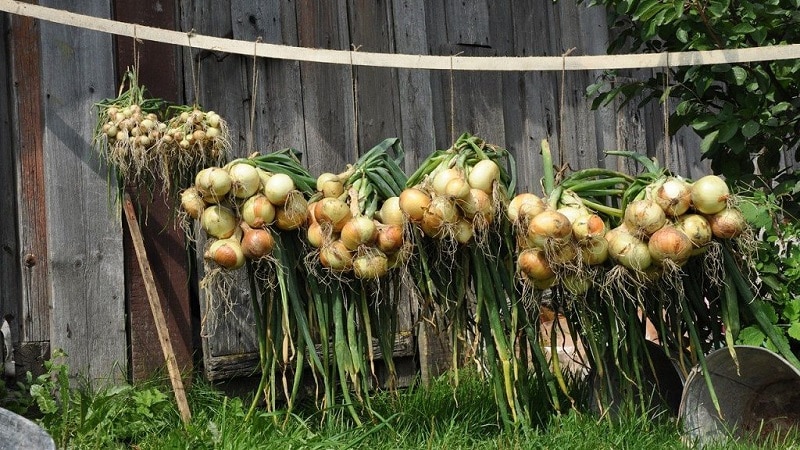
Shelf life
The dried vegetable is stored in a dark, dry place without foreign odors.. The shelf life of dried seasoning is about one year.
Dried bulbs from the garden should be firm to the touch. and have several dry, dense integumentary scales. The neck of each head should be tightly closed (there are no voids or succulent leaves on the cut).
If storage conditions are observed (temperature from 0 to 5°C and humidity 50-60%), healthy dried heads are stored for several months.
Common drying and storage problems
If the summer is cold and rainy, the onion ripening period increases. In this case, ripening can be accelerated by cutting the roots or raking the soil away from the bulbs.
Choose a dry, sunny day for harvesting - onions removed from wet soil will require a long drying time and will be stored worse.
If you have to dig up onions with green, fresh feathers, then the greens are not cut off immediately. The bulbs are dried under a canopy for another week, and then the dried feathers are cut off.
After the vegetable is placed for storage, he is periodically examined. Instances with signs of rot or pest damage are removed.
Conclusion
Now you know how to properly and efficiently dry onions at home. The importance of the drying process should not be underestimated. Storing insufficiently dried heads will lead to the development of fungal diseases and rotting of the product.
You can also prepare this healthy vegetable for the winter in dried form. At the same time, it will not lose its beneficial properties.